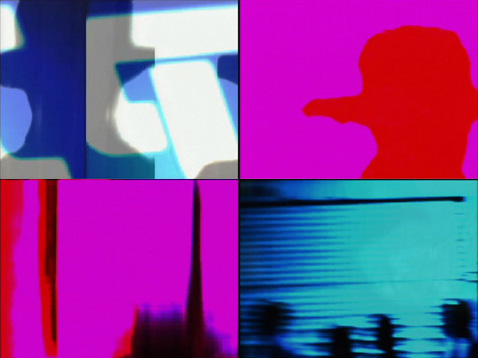CODEWORK
Mark Amerika's CODEWORK is a self-contained, multi-media installation that includes digital projection and 5.1 surround sound.
CODEWORK centers around two figures, an artificial intelligence known as the "Digital Thoughtographer," and a disembodied woman whose scripted voice-over telepathically communicates with this alien shadow figure. Amerika's painterly video style is synchronized with the 5.1 surround sounds which are made in collaboration with the sound artist Chad Mossholder and utilize the voice-over of Berlin actress Jutta Wolfert.
Amerika developed the abstract motion image sequences after having toured Japan and Europe as a VJ in museums, universities, festivals, and techno-clubs. The video source material comes from footage shot in Tokyo, Hong Kong, Hawaii and the Australian Outback. The soundtrack was developed in close consultation with Mossholder who uses Wolfert's vocals, scripted by Amerika, as well as sounds captured on video and other manipulated sources, to further intensify the experience of watching the trancelike images being projected on the wall inside the black box the installation takes place in.
Denver Art Museum
A limited edition version of CODEWORK was purchased by the Denver Art Museum and was on exhibit there during the summer of 2004. Other exhibitions of CODEWORK have occured at Amerika's META/DATA retrospective exhibitions in Bilbao, Spain, and at the Gallerie de Arte do SESI in Sao Paulo, Brazil. A limited edition DVD of CODEWORK is still available for purchase. For more information, please contact the artist.

The CODEWORK Experience
CODEWORK no longer tells the story of Dziga Vertov's Man With A Movie Camera. Instead, it tells the story of the Digital Thoughtographer, an artificial intelligence living in the digital afterlife. The narrative is presented as a kind of philosophical game that invites the viewer to constantly search for new forms of meaning, and is composed as a serial network of interconnected moving image sequences with an addictive soundtrack. These sequences are projected as a fluid yet perfectly time-coded cluster of short, dream-narrative events that slowly
reveal how the protagonist is using a digital video camera as a writing instrument that simultaneously records and translates the trancelike states of mind being experienced in realtime. The curators and directors at the major exhibitions the work has appeared in convey the same phenomenon: a rise in the number of visitors who never go to art venues but come from other parts of the youth culture, particularly club, DJ/VJ, and rave culture, and who are then introduced to other aspects of the host's art collection.